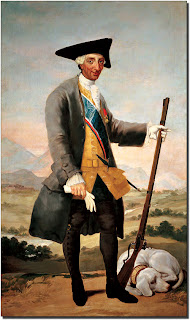 |
Charles of Bourbon, Piazza del Plebiscito, Napoli
b. January 20, 1716 – d. December 14, 1788
Photo by New York Scugnizzo
|
"Go forth and win: the most beautiful crown in Italy awaits you." – Elizabeth Farnese to her son Charles of Bourbon*
Charles of Bourbon was born on January 20, 1716 in Madrid. He was the eldest child of King Philip V of Spain and his second wife, Elizabeth Farnese. Through conquest and diplomacy the monarchs acquired the ducal crowns of Tuscany and Parma for the young Prince. Not content with these titles, the ambitious royals believed the Kingdom of the Two-Sicilies to be a more fitting prize for their son and plotted to wrest the Regno from the Austrian Empire.
At the age of eighteen Charles descended from his ducal dominions to invade the viceroyalty and conquer the "the most beautiful crown in Italy" for his own. At the helm of his army, which was composed of sixteen thousand infantry and five thousand cavalry, was the illustrious Captain General José Carrillo de Albornoz, the Count of Montemar. They had the support of the Spanish navy.
When the Bourbon forces crossed the frontier they met with minimal resistance as the Austrians yielded in rapid succession. Charles entered Naples on May 10, 1734. Awaiting reinforcements from Austria, the imperial viceroy, Giulio Visconti, retreated with the bulk of his forces to Puglia. However, because the Austrians were tied up in Lombardy fighting against the French and Sardinians in the War of Polish Succession (1733-1735) the expected help never arrived. Upon hearing the news of the advancing Bourbons the viceroy wasted no time and set sail for Vienna.
 |
Charles of Bourbon, Napoli
Photo by New York Scugnizzo
|
On May 25th, outside the town of Bitonto, near Bari, the Bourbon forces, numbering about 12,000 strong, under the command of the Count of Montemar, clashed with 8,000 Austrians led by General Pignatelli di Belmonte. Outnumbered and disheartened, the Austrian ranks quickly broke. Belmonte fled with the remnants of his cavalry into the Abruzzi. Abandoned, the remainder of the imperial forces were killed (1,000) or captured because in their haste to escape their leaders neglected to sound the retreat. The Bourbon columns continued their advance and Bari was taken. For his valor and success Count José Carrillo de Albornoz was made a Duke.
 |
The Duke of Montemar,
José Carrillo de Albornoz
|
On June 15th the Prince published his father's decree relinquishing his ancient rights to the Kingdom. Charles declared himself King of the Two Sicilies, Jerusalem, Infante of Spain, Duke of Parma, Piacenza and Castro, and Hereditary Grand Prince of Tuscany. Tired of being a provincial backwater of the Austrian Empire the Neapolitans welcomed the conqueror at the Porta Capuana, as was the tradition.
Nonetheless, the new King still had to secure his realm. Isolated pockets loyal to the Empire still held out.
Next, preparations for the expedition to Sicily were made. On the 23rd of August the fleet set sail from Naples and Baja. Half the armada headed for Palermo, the rest landed at Messina. Learning of the Spanish fleet's approach the imperial viceroy of Sicily, Marquis Rubbi, fled to Malta. The remaining Austrian garrisons took refuge in the castles and were besieged. On August 30th Charles entered Palermo to the cheers of the people welcoming their new king.
 |
| Charles was engrossed with the chase |
An avid hunter, not even the war could keep the King from practicing his favorite pastime. One day, while hunting near Rosarno, Charles and his retinue sought shelter from a violent storm in a nearby shack. Inside they found a young woman who had recently given birth to a boy. The King requested that the newborn be named Charles and vowed to be the infant's godfather. The mother was given 100 gold doubloons and a monthly stipend of twenty-five ducats to raise the child. At the age of seven the boy was to be brought to the palace for employment.
One by one, after several months of sieges and blockades the remaining Austrian fortresses surrendered. On November 24th Capua, the last Austrian stronghold on the mainland, capitulated. It's Commander, the valiant Count Traun, and garrison were escorted to the Adriatic and safely transported to Trieste. The final vestiges of the Empire were weeded out. With the fall of Trāpani the conquest of the Sicilies was complete.
On July 3, 1735 in the Cathedral of Palermo (as was the ancient custom), Charles was proclaimed King. Nine days later he returned to Naples, his new capital, in triumph. With the conclusion of the War of Polish Succession and the treaties ratified, Charles ceded Parma, Piacenza, and Tuscany, and in return the Austrian Emperor (Charles VI) renounced all claim to the Kingdom of the Two Sicilies. After centuries of provincial servitude to Spain, then to Austria, the once great and independent kingdom was redeemed.
* Quoted from The Bourbons of Naples by Harold Acton, Methuen and Co. Ltd., 1957, pg. 17









